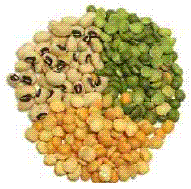Legumes: A Healthy Addition to Any Diet!

Why should I eat legumes?
Legumes are loaded with nutrients that are important in preventing heart disease, cancer, obesity, and other chronic diseases. Nutritionists recommend several servings of legumes per week because they are nutrient-dense. That means they contain a lot of nutrients (such as protein, iron, potassium, selenium, magnesium, zinc, B vitamins, and fiber) in relation to the calories. In other words, they are a good deal for the amount of calories they supply! Even better, they have no cholesterol and little fat and they are relatively inexpensive. In addition, the soluble fiber in legumes helps to lower blood cholesterol, while the insoluble fiber helps to regulate the digestive tract and prevent constipation.
How can I include legumes in my diet?
Increase the amount of legumes in your diet gradually to avoid intestinal gas that may result during digestion. Here are some shopping and cooking tips:
- Choose legumes of a uniform size so that they cook more evenly. Check that the legumes are not cracked or moldy.
- Buy legumes with a deep color. Legumes fade and lose some of their flavor when they are stored for a long time.
- Store dried legumes in an airtight container away from heat, light, and moisture.
- Store canned legumes in a cool, dry place. Canned products are convenient, but they may be high in sodium and less tasty than the dried varieties.
- Rinse legumes before use.
- Soak large, dried legumes (such as beans and chickpeas) in room-temperature water overnight to rehydrate them before cooking. The longer they soak, the softer they become.
- Prepare soups and casseroles that include legumes.
- Use pureed beans as the basis for dips and spreads.
- Add chickpeas or black beans to salads.
Legumes have always been a primary source of protein in many cultures and in vegetarian diets (1/4 cup of legumes equals 1 ounce of animal protein). Due to the growing interest in ethnic cuisines and plant-based, healthy diets, we are seeing an increase in the popularity of legumes. So the next time you are at the grocery store, pick up a variety of legumes that you have never tried and enjoy!
For more information:
Go to the Diet and Nutrition health topic.